Low Fell History
History of Low Fell
Welcome to Low Fell history starting in the 16th Century when coal was first mined in what is now Low Fell, 18th Century when the major Collieries developed, John Wesley came to preach to the pitmen, raggedy children and rogues, the Enclosure Act of 1809 and other 19th Century developments in the Low Fell history,
Most of the pictures on this web page are from Gateshead Council's fantastic photographic collection now available online at
isee
The New Durham road was carved through the fields, Thomas Wilson created a school and wrote poems while getting rich, Joseph Swan brought us light, more collieries opened replacing the many that closed, Churches were built, financed by the business men who built the big houses that sprang up along the New Durham Road ...and Saltwell Park was born...and then Low Fell history reached the 20th Century when all the rich houses and/or the land became a College (Enfield), Grammar School Annexe (North Dene) Hospital (Whinney House) Private Schools (Musgrave) (Underhill) Co Ed Grammar School (Heathfield) Nursery (Chesters) Park (The Grove)
The Potted History Of Low Fell
The "Gosforth of Gateshead"
1530 Approximate date a licence was given for coal to be mined on land later to become Low Fell.
1700s The whole place was filled with Chavs, Ne're-do-wells and little tinkers
1726 Ravensworth Ann Colliery (The Ann Pit) opened (closed 1973)
1771 John Wesley visited Low Fell...things are looking up 1774 Thomas Wilson was born...lowly born...made good. A well known Low Fell trait
1809 Enclosure Act
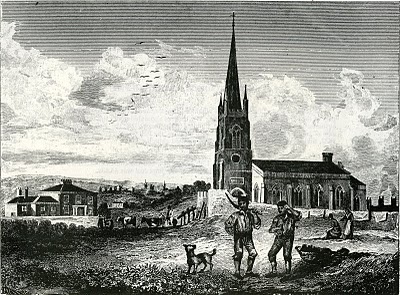
1825 St. John's Church was opened, financed by the rich Mr Hawks
1826 New Durham Road was built. The "Fell" was born
1826 Springwell Colliery opened (closed 1932)
1841 Thomas Wilson reading/school room was opened
1850 Ravensworth Shop Colliery ( Allerdene Pit) opened (closed 1962)
1858 Thomas Wilson died
1867 Whinney House was built
1869 Joseph Wilson Swan moved to Low Fell..lived in Underwood on Kells Lane and had a great idea... which resulted in Underwood being the first house in the World to be lit by electricity

Welcome to Low Fell history starting in the 16th Century when coal was first mined in what is now Low Fell, 18th Century when the major Collieries developed, John Wesley came to preach to the pitmen, raggedy children and rogues, the Enclosure Act of 1809 and other 19th Century developments in the Low Fell history,
Most of the pictures on this web page are from Gateshead Council's fantastic photographic collection now available online at
isee
The New Durham road was carved through the fields, Thomas Wilson created a school and wrote poems while getting rich, Joseph Swan brought us light, more collieries opened replacing the many that closed, Churches were built, financed by the business men who built the big houses that sprang up along the New Durham Road ...and Saltwell Park was born...and then Low Fell history reached the 20th Century when all the rich houses and/or the land became a College (Enfield), Grammar School Annexe (North Dene) Hospital (Whinney House) Private Schools (Musgrave) (Underhill) Co Ed Grammar School (Heathfield) Nursery (Chesters) Park (The Grove)
The Potted History Of Low Fell
The "Gosforth of Gateshead"
1530 Approximate date a licence was given for coal to be mined on land later to become Low Fell.
1700s The whole place was filled with Chavs, Ne're-do-wells and little tinkers
1726 Ravensworth Ann Colliery (The Ann Pit) opened (closed 1973)
1771 John Wesley visited Low Fell...things are looking up 1774 Thomas Wilson was born...lowly born...made good. A well known Low Fell trait
1809 Enclosure Act

1825 St. John's Church was opened, financed by the rich Mr Hawks
1826 New Durham Road was built. The "Fell" was born
1826 Springwell Colliery opened (closed 1932)
1841 Thomas Wilson reading/school room was opened
1850 Ravensworth Shop Colliery ( Allerdene Pit) opened (closed 1962)
1858 Thomas Wilson died
1867 Whinney House was built
1869 Joseph Wilson Swan moved to Low Fell..lived in Underwood on Kells Lane and had a great idea... which resulted in Underwood being the first house in the World to be lit by electricity


(He was a Mackem but saw the light )
27th May 2014 is the centenary of Sir Joseph Swan's death
1883 Wesleyan Memorial Church was opened.. well planned, having as it has, hidden back alleys where underage booze could be consumed before going to the dance in the Church Hall
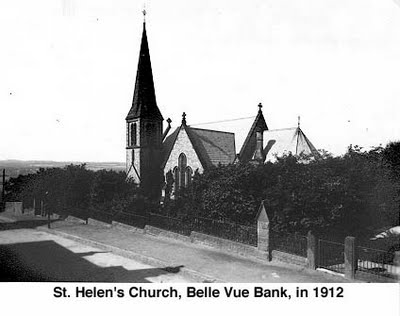
Left click the image to see it today
1876 St. Helen's Church was opened, financed by the rich Mr Joicey...see later
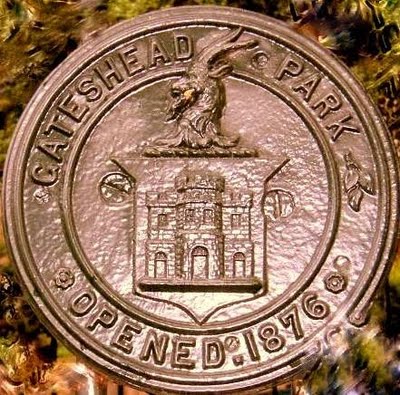
1876 Saltwell Park was opened
1902 Boer War memorial was erected
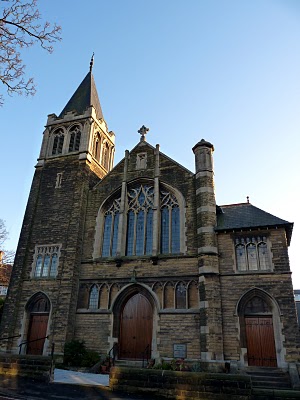
1914 Denewell Avenue Presbyterian Church was opened, which in the Sixties had a great Youth Club...I recall
1921 Whinney House estate was sold and it became a hospital
1936 Work began on the Team Valley Trading Estate.
1951 Trams stopped running along Durham Road... 19.51 That's just before 8 o'clock pm., which is bad news for Birtley folk who know the Fell is just a lot better for pubs and restaurants
Most of what follows has been extracted from the 1965 work of M. Hope Dodds, all of which can be seen by clicking on the link
.
The Church History of Low Fell, Gateshead
THE WESLEY CONNECTION
In the 18th century Gateshead Fell was still an open moor, and on it there were many squatters, tinkers and gypsies who built themselves hovels out of any materials that came to hand, hence the name of Sodhouse Bank. But there were also authorised enclosures and stone built houses. William Bell and Jane his wife had a bakery where the present Wesleyan
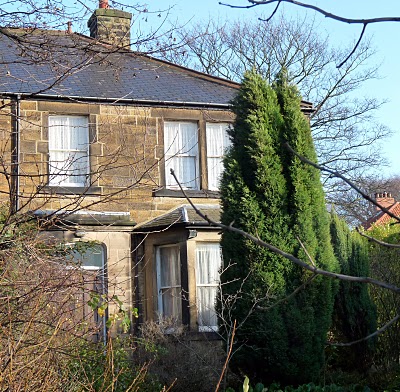
Manse now stands on the north side of Church Road. It used to be called Meeting-House Lane, because it went past the Wesleyan chapel, but after St. John's Church was built it began to be called Church Road
27th May 2014 is the centenary of Sir Joseph Swan's death
1883 Wesleyan Memorial Church was opened.. well planned, having as it has, hidden back alleys where underage booze could be consumed before going to the dance in the Church Hall

Left click the image to see it today
1876 St. Helen's Church was opened, financed by the rich Mr Joicey...see later

1876 Saltwell Park was opened
1902 Boer War memorial was erected
1914 Denewell Avenue Presbyterian Church was opened, which in the Sixties had a great Youth Club...I recall
1921 Whinney House estate was sold and it became a hospital
1936 Work began on the Team Valley Trading Estate.
1951 Trams stopped running along Durham Road... 19.51 That's just before 8 o'clock pm., which is bad news for Birtley folk who know the Fell is just a lot better for pubs and restaurants
Most of what follows has been extracted from the 1965 work of M. Hope Dodds, all of which can be seen by clicking on the link
.
The Church History of Low Fell, Gateshead
THE WESLEY CONNECTION
In the 18th century Gateshead Fell was still an open moor, and on it there were many squatters, tinkers and gypsies who built themselves hovels out of any materials that came to hand, hence the name of Sodhouse Bank. But there were also authorised enclosures and stone built houses. William Bell and Jane his wife had a bakery where the present Wesleyan
Manse now stands on the north side of Church Road. It used to be called Meeting-House Lane, because it went past the Wesleyan chapel, but after St. John's Church was built it began to be called Church Road
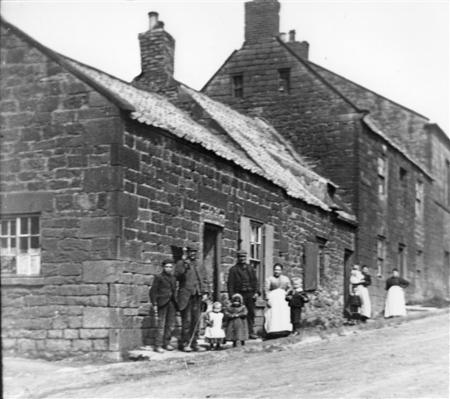
As you can see in the photograph there were two cottages attached to the bakery in one of which the Bells lived. When John Wesley came to preach in the north, in the latter part of the 18th century, the Bells became his followers and added a building to the bakery as a chapel. Wesley often rode along the highway which is now the Old Durham Road, but was then the only main road, and he greatly admired the view from the top of the Fell. Two rooms in the meeting-house were known as Wesley's rooms, and on one of the small panes in a window there was written with a diamond "God is Love". J. Wesley 1771".
The pane of glass is preserved in the Wesleyan church, allegedly. Subsequently, there was a small methodist meeting house that was demolished because it stood in the way of the new Durham Road, built in 1826
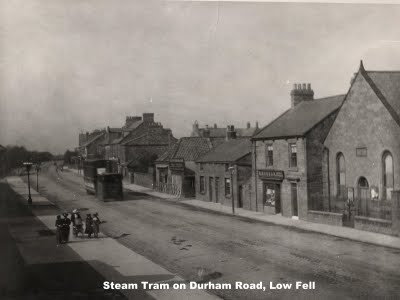

Left click to see it as it is now
but another, Bethany Chapel, building on the left, was built to replace it on the east side of the road. This is now Greggs the Bakers.
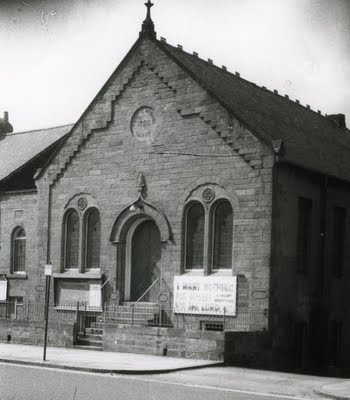
Left click the image to see it now
Chowdene Chapel (above), no longer Methodist, on the west side of the road was then" it " until the current Wesley Memorial was built in 1882, opened 1883
ST. JOHN'S CHURCH
The building of St. John's was financed by the Hawks family who owned large ironworks on the Tyne. The church was completed and opened in 1825, the Rev. William Hawks was the first rector, and the rectory was built for him by his father, Sir Robert Shafto Hawks.
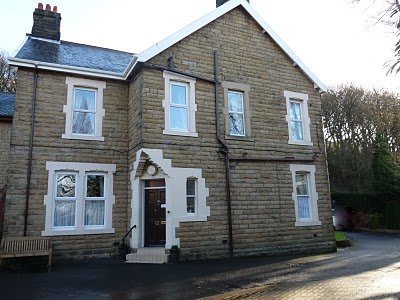
The Rectory, Hawksbury House, is at the top of Kellfield Avenue and is now a residential care home. The church stands on almost the highest summit of the Fell, Sour Milk Hill. It is over 500 feet above sea level, one of the highest in England. The spire of St. John's church is a landmark and can seen for many miles in Northumberland and Durham, and from the sea;. The Hawks family made other benefactions to the church. Lady Hawks gave the communion plate, for example. To this day, just to the left of the east gate to the grave yard, leaning against the wall is the gravestone of Dorothy Smith in the servitude of Lady Hawks for 50 years..only that bit can be made out. Thomas Wilson, the Bard of Low Fell is buried in the grave yard as is Robert Clement of the New Cannon Inn...at the west boundary wall of the graveyard, near the main entrance of the church
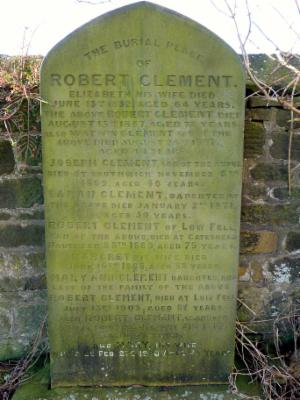
The Parish of Saint Helen owes its existence to the large population explosion. Low Fell had been but a small village on the Southern edge of Gateshead - coal mining being the principal occupation. The opening of the Gateshead to Durham Turnpike in 1827 served to put Low Fell on the map and many of the industrialists of Gateshead and Newcastle built large houses in the area, this being followed by a steady growth in population generally. It was a hellava hike up to St John's and so the entire cost of the Church - £13,000 - was met by Edward Joicey of Whinney House, Low Fell who was a partner in the firm of Joicey and Co., colliery owners. The Church was consecrated on 29th August 1876. There's loads more on St Helens Website
Low Fell History must include it's famous son,
THOMAS WILSON
Thomas Wilson is the name of the best known character who was a native of Low Fell, though his fame did not spread beyond the district in which he lived.
He was born on 14th November 1774, in Low Fell. His father was a pitman. There was no restriction on child labour in the eighteenth century, and Thomas Wilson went to work in the pit when he was eight years old. He must have been a clever child who had already learned to read and write.
He worked in the pit until he was nineteen, and then began to teach in a school at Galloping Green about a mile from Low Fell. It must have been just such a little village school run by the schoolmaster for his own profit as the one in which Thomas Wilson had been taught as a small child.
After some years of teaching in this and other schools, where the pay was probably even less than he could earn in the pit, he got a job as a clerk in a Newcastle firm.
After several years of experience with different firms in Newcastle, he was taken into partnership with William Losh and Thomas Bell, forming the engineering firm of Losh, Wilson and Bell, and also the chemical firm called the Alkali Company, in the year 1805, the year of Trafalgar.
Thomas Wilson prospered. He married and had children.He bought a house with large grounds on the land between the New Durham Road and Kells Lane. Thomas Wilson's house faced onto Weathercock Lane, which connected Kells Lane with the new road, and his ground extended to Lowrey's Lane, the next street connecting the two roads. Wilson's house was called Fell House, and had a gate opening onto the main road as well as the entrance from Weathercock Lane. Fell House was situated on what we now know as Lowrey's Lane Car Park, the entrance and frontage of the grounds extending from Sunlight Cleaners to the Chinese Takeaway
Thomas Wilson wished to help children to get a better education with less difficulty than he had known and also to encourage adult education, therefore as soon as he was in a position to do so he set to work to establish a reading room and school in Low Fell.
On the opposite side of the new Durham Road to Fell House there was a level open piece of land, with the Crown Inn on its north side. The Crown Inn is now Bar Mondo The site was bought from William Laing in January 1841.
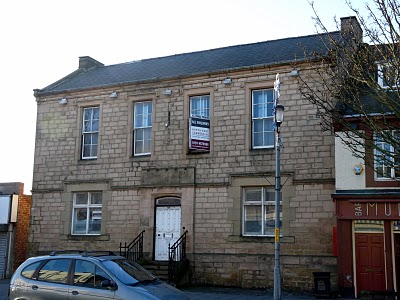
Money was raised by two issues of five shilling shares, which produced two-thirds of the amount required, and the remaining third was raised by public subscription. The chief organisers in the project were Thomas Wilson and Mr. Hetherington, the landlord of the Gateshead Arms. It may be remarked that there was a staircase leading from the reading-room to the Crown Inn, but this was subsequently closed. The architect was Thomas Oliver of Newcastle, and the builder Thomas Liddell of Low Fell. There was a grand opening dinner on 9th November 1841. The building contained a reading room, lecture room and schoolroom. Seven trustees, headed by Thomas Wilson, were appointed to manage the use of the building for its proper purposes.
The Pitman's Pay, Wilson's chief literary work, appeared originally in Mitchell's Newcastle Magazine in 1826-28 and 1830. Other poems were contributed to the Tyne Mercury and some of these were reissued with notes by John Sykes, compiler of local records. The Pitman's Pay is a metrical description, much of it in mining language, of the incidents and conversations of colliers on their fortnightly pay nights. Others of Wilson's verses, the poem entitled 'On seeing a mouse run across the road in January' for example, show him to have made a close study of Burns. Some consider that in the 'Tippling Dominie' Wilson is perhaps seen at his best.
Wilson died at age 84 at Fell House, Gateshead, on 9th May 1858 and was buried in the family vault at St John's. His funeral was attended by the Mayor and town council.
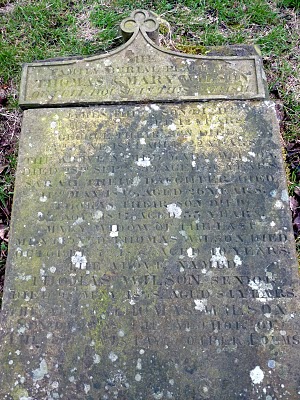
The grave is in an extremely neglected state
It is not possible to read all of the inscription but the heading reads The Family Burial Place of Thomas and Mary Wilson of Fell House in this Parish
It also says Thomas Wilson Senior...is the author of the Pitman's Pay and other poems
Who reckons, like me, that it would cost the Council very little if it got it's Parks Dept to keep the burial place in better order?
The Pitman's Pay is extremely long and can be read by clicking the link
lIn 1923 Lloyd's Bank bought the Wilson school building. No longer a bank the building is up to let
The History of Low Fell continues with...
THE BUILDING OF DURHAM ROAD THRO LOW FELL
To the people who urged that it was too hard on the horses to have to drag coaches and wagons up a long steep hill (that was Old Durham Road) and then down another( way, way down to Birtley), the canny folk of Wrekenton replied that horses liked a variety of level and thrived on up and down roads while they found a more level line exhausting:
here's Thomas Wilson
"For the very wise heads up at Wrekenton Town
Had labour'd to settle these two simple points,
That the horses' delight is an up and a down,
A hill clears their wind and relaxes their joints."
Pull the other one, Wrekendykers
The new road began 6th December 1824, and the first mail coach passed along it on 16th June 1826. This was just when the supremacy of the mail coach began to be threatened, when George Stephenson's first steam train ran from Stockton to Darlington.
The meeting between the judges of assize and the representatives of the lords of the franchises to claim their right to hold their own courts had long ceased to be held, but it was still the custom for the High Sheriff of Northumberland and the under sheriff to come in procession to meet the judges, followed by a train of the gentlemen of the county on horseback or later in their carriages. It is said that a popular sheriff might be followed by as many as 500 gentlemen's carriages. The meeting-place was now the Cannon Inn at Sheriff Hill.
After the opening of the new main road, the New Cannon Inn was built at the foot of Buck Lane, now Beaconsfield Road, and the Sheriff's procession met the judges there as they travelled north with equal pomp, until the opening of the railway gave the judges an easier method of travelling.
Thomas Wilson described it as "the road through the fields" In 1824 there was still about a mile of farm land between Gateshead and Low Fell, with farms and cottages scattered about. Dryden's farm was where the modern fire brigade station stands, and gave its name to the modern Dryden Road. Thomas Wilson's poem about the new road can be seen
Here's a verse from it
"Then reet ower the Fell, and by Carter's famed well,
Wheer the watter like wine ye see a'ways runnin',
And is better by far than the poor blashy yel (ale)
Folks get i' Newcassel or even i' Lunnen"
.
To this Wilson added a note: "A famous spring, taking its rise in an old pit, and issuing from a hillside on the Low Fell. It affords the inhabitants a healthy and sober beverage, free from the pernicious effects produced by the rotten stuff, often drunk under the name of ale. Of course I except home-brewed and fine old eight-penny."
Carter's Well was the chief drinking-water supply for Low Fell until near the end of the 19th century.People would take buckets to the well and bring them back full of the water to be used for drinking and cooking. Rain water would be collected for washing and cleaning the floors.
The mail coach first went along the road on 17th June 1826, and Wilson continued his stanzas.
"How 'way, Dicky, how 'way, hinny,
There's the tootin o' the horn!
If it cost a gowden guinney
Thou's be soaked wi' barley corn."
Accordingly they went first to the Buck (The Beaconsfield ) then to the Keys, (The Belle Vue) which gave its name to Cross Keys Lane, then to The Black Horse. Everybody was having a holiday, the horses and the donkeys, rejoicing that they would no longer have to toil up steep hills, the carriers, the smiths, the tailors, the cobblers, the school children and their masters. Dicky burst into a song of triumph. The Fell will be a new Garden of Eden, better than Adam's. The "jay-legg'd bodies frae the toon", in other words, the citizens of Newcastle, would no longer be able to look down their noses on the Low Fellers. We would grow grapes and peaches, there would be peacocks instead of cocks and hens, and all the mice would be white!
Best of all the magistrates had granted licences for four new inns! The Ship, (where was that?) the <<<Cannon, otherwise the New Cannon,(now Ye Olde Cannon) right on the new road at the foot of Buck Lane,(Beaconsfield Road) named after the Old Cannon on Sheriff Hill, the Engine (bottom of Engine Lane where Fell Tower Medical Centre is now), and the Sovereign (the George IV (now Aletaster).
Moulders Arms, a few doors to the South of the Belle Vue in Low Fell (the premises is now occupied by Rumour hairdressers). It closed and the licence was transferred to the Bell Vue.
To see more old photos of some of these pubs go to "Remember When" on www.gateshead-pubs.com
Dicky, in the poem, was a well known local character, Dick Fenwick of Sheriff Hill House, who was the manager of a small colliery on the west side of the new road, on the steep hillside behind the old Co-op (now a pine bed showroom) and the new flats (formerly The Capitol) See 1862 map. He used to gallop down Church Road from his house at the top to his colliery at the foot at breakneck speed. Cedar Crescent is built over the site. Dicky's Dene( Officially called Dodds' Dene) lay immediately to the south of it. Sheriff Hill House is shown on the map in the Kells Lane section below
The engine house of Dicky's colliery was on the east side of the main road and gave its name to Engine Lane The Engine House became The Engine Inn and ultimately the site was used for the building of the Fell Tower Medical Centre
<One of the earlier residential terraces to be built on the east side of the new Durham Road, ( completed 1826 )
THE HISTORY OF LOW FELL cont...d
THE POSH HOUSES ALONG DURHAM ROAD
Along the west side of Durham Road, starting at Enfield Road, the foot-path was bordered by a line of high walls, with more or less stately gates at intervals opening onto carriage drives, and usually with a lodge beside the gate. The drive led to a large house, with a flower garden.
At least two of the houses stood at the top of a hillside which might almost be called a cliff. Others were built at the upper end of a dene. Several of them had denes in the garden, which were put to various uses. A large conservatory was built over one, with the furnace and boiler for the hot water pipes underneath it in the dene, which of course was strictly utilitarian and hidden from the rest of the grounds by trees and shrubs.
Enfield House, the first of the big houses on the West side. Enfield House was pulled down and the rest of the estate is covered by Gateshead Technical College, now Gateshead College.
North Dene, the building and the grounds were still very nice in the early sixties when it was used as overspill accomodation for The Grammar School for Boys
It has now been absorbed into Gateshead College and the grounds turned over to portacabins and tarmac for car parking
The Red House, to the south of North Dene, was built later than the other big houses. Below it was Ravenshill (now demolished), once the home of the artistic Sowerbys, the owners of a glass works for which Gateshead was once famous.
The houses and grounds became more and more fantastic the further they were from the town.
The house with the conservatory built over the dene was called Heathfield, and had most remarkable grounds. The carriage gate onto the main road was very elaborate with a tall stone arch on each side and a stone lion on each
This photo was taken April 2005
In the grounds there were artificial mountains, complete with winding paths, boulders and pine trees, and a full-size metal eagle on the summit. There were other lions and eagles here and there a lake with a boat and boathouse, and an island in the lake on which stood a glass pagoda. This fantastic place belonged to a family called Lange who came from Germany and made their fortune in the coal trade. The elder was a very good business man; he never married. The younger brother married - he was the one with the romantic mind who planned the Heathfield grounds. Whenever he wanted to add a mountain or a few more lions and eagles, he told the other brother, who made some more money and gave it to him to pay for the improvement.
The grounds of all these great houses extended from the main road downhill to a very minor road called officially East Park Road and colloquially the Low Lane. On the east side of the Low Lane were the walls of the great houses, each with a door in it, and one or two with a dreary little lodge, which never seemed to be inhabited. On the west side was the public park, about which there will be more hereafter. It was bounded by tall iron railings so that the grass and flower beds could be seen. There were trees on both sides of the road which was very quiet, with hardly any traffic. The Heathfield grounds extended to the Low Lane, but on the south of Heathfield there was a field extending from the main road down half the side of the Heathfield grounds. On this field in the 1920s was built the last of the big houses, not so large as the others, with a garden beautifully laid out and kept. This is called the Chesters, though I do not think any Roman remains were ever found there. Chesters Park has been built on the grounds of The Chesters which is now a residential care home.
The garden at Heathfield was laid out in the romantic gothic style of the early 19th century, but the garden at Ashfield was designed by John Hancock in the still older landscape gardening style It is true that it had been provided with a quantity of artificial rocks, but they were overgrown with moss and bedded in grass and wild flowers. On the ridge of the steep sides there were four great old Ash Trees which gave the place its name, one at the foot, on the north side, two in the south side and one at the top of the dene, the oldest of all and covered in ivy.
The grounds of all these houses adjoined one another, and there was no road to connect the Durham Road with East Park Road, the Low Lane, before Joicey Road, which was immediately to the south of Ashfield. The side gate of the house opened onto this road and a footpath led through the garden down to the house, but the main gate with its lodge and carriage drive was on the Low Lane, the only main gate on the east side of that road, but there was one house with a gate and drive on the west. side, next to the Park. Ashfield House, photo above, is now a Nursery and is to the rear of Springs Fitness Centre on Joicey Road. The Lodge on East Park Road is of later date (1903) than Ashfield House. The gate on the west side of East Park Road is that of Grove House.
On the south side of Joicey Lane comes the only estate which was mentioned by Thomas Wilson, Whinney House. When the road was opened in 1826 it must have been a large farm not at all like its later appearance. In the middle-of the 19th century
there were four brothers who were colliery owners in Northumberland and Durham, all very rich. The youngest, whose health was poor, was not quite so rich as the others, but he was rich enough to buy Whinney House, build himself a large mansion, and lay out elaborate grounds over the former fields. This was much the largest of these great houses. The grounds stretched from Joicey Road to the first houses in Low Fell village. The principal gate was on the main road with lodge and drive. The grounds extended down past the end of the Low Lane to West Park Road. The dene in the Whinney House grounds was a very large one, to suit the size of the place. There was a deep dip in West Park Road, and at that point there was a third gate into the grounds, not an imposing one in itself, but it had quite a large house for a lodge, with its name on the wall, "The CWM" a puzzle for at least one youthful passer-by, for how could you pronounce CWM? I suppose now that Mr. Joicey thought his valley was larger than a dene, it was a combe. It was very lovely in springtime, full of flowering trees, apple and cherry and red and white hawthorn. The West Park Road referred to here is now Saltwell Road South. Old maps do not show an entrance to Whinney House from West Park Road although there was a house in the dip opposite the Ninepins at the foot of the dene. This house was demolished and two houses erected on the site. An entrance into the grounds of Whinney House is shown on Joicey Road (now an entrance to allotments).
Having dealt with the houses on the west side of the main road from Shipcote to the village of Low Fell, we must cross to the east side. The two houses farthest to the north were built early in the 20th century, later than most of the houses on the west. One, Springfield House, stood behind the later Springfield Hotel. It was demolished and the hotel extended.
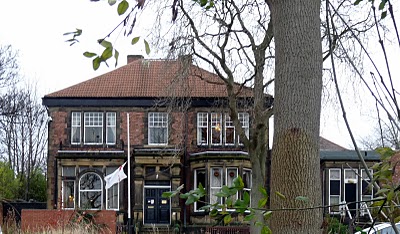
The other, with a large garden separating it from the main road, is Lindum House; in the centre of the roof there were two chimney stacks connected by ornamental metal-work, and so the house was known as the House with a Handle. It is now the Lindum Club.
The stumps of the chimney stacks
can still be seen
South from it there was a succession of fields which were formerly used for corn and hay, then later for pasture, and now they are covered with streets.
Another large house was much farther to the south, about opposite to Heathfield. It was called Musgrave and was built for the Allhusen family, who were of German origin like the Langes, and had chemical works on the Tyne. It is in the William Morris style, but in a much more agreeable form, with stone walls and a slate roof, no red and white brickwork - rather narrow pointed gables and tall slender chimneys ornamented with plasterwork. The lodge was a low building, with diamond-paned casement windows and a general medievalish look. The garden was surrounded by a high stone wall, above which appeared the tops of rowan trees covered with creamy-white blossom in early summer and with scarlet berries in early autumn. The house and front garden still are there, for a long time it was a private school, and then neglected for a long time and this photo was taken in April 2005 before it was converted into appartments
THE HISTORY OF LOW FELL cont...d
SALTWELL PARK
This picture, and several others elsewhere on this page, are from http://www.picturesofgateshead.co.uk/postcards_gateshead1/ which has lots, lots more and is well worth a visit
1876 saw the opening of Saltwell Park.
The Park is in 3 bits. This bit is the large northern area comprising the Northern Field (for picnics and events) the play areas for kids, the lake, tennis courts and bowling greens. Nice but utilitarian, as is the southern bit which is
The Grove, the grassed area that contains the bandstand. This is Grove House. It looks majestically down The Grove and is, within the curtilage of the Park, but separated from it by a wooden fence.
The crowning glory of the park is the middle bit, the house and grounds bought from William Wailes, who made his money designing stained glass.
At the south end of his estate he built South Dene Towers, a fantastic castellated building in red and white brick, with two towers. He let it out.
(South Dene Towers >>>was demolished and the Crematorium and grounds now occupy the site )
Meanwhile in 1871 Mr. Wailes built himself another house, larger than South Dene Towers, called Saltwell Towers, in the middle of his large grounds.
As you can see ( the coloured photo above) it was also in red and white bricks and in the same Gothic, Elizabethan and French styles, an effect that would not be out of place in Disneyworld ).
Mr. Wailes continued to live in Saltwell Towers until his death in 1881, and after that it was let from time to time to various tenants, including J A Shipley who founded the Shipley Art Gallery, and then became the park museum. This is the goat pub sign exhibited at the Park Museum. There was also a decaying whale bone just outside the entrance, I recall. Saltwell Towers became unsafe and was closed in about 1970. Restoration has now been carried out as part of lottery-funded park renovation and the building reopened in 2004 as a visitors centre, cafe, and events area.
The Goat was in the house that Mr J A Shipley occupied and now it's on the wall of his Art Gallery...in the shop/vestibule area.
Lovely, I know it is ... but is it art?
Personally I think it should go back to Saltwell Towers which, while beautifully restored, is a bit boring inside and needs a Golden Goat, in my opinion
Indeed the cafe should be licensed and called the Goat Inn... Saltwell Park is the People's Park and the people want ale.
Gateshead Council, I hope you're taking notes
This is a map of the jewel in the crown.
4) is the salt well (see pic below)
5) is a Lodge House ( now called Dene House) also shown on pic
6) is the other Lodge House
7) is the rose garden
8) is themagnificently restored dene. It is truly beautiful and
MUST be visited
9) is Saltwell Towers
10) is the Animal/Bird area
11) Wailes' original stables, now an education centre
12) is South Park
13) is the restored maze, exactly as it was when Wailes built it for
his own family
14) is the octagonal garden
< This is 6) the other Lodge House
Detail on the gable end. This was built after the Park was created in 1876
THE HISTORY OF LOW FELL Cont...d
THE PUBS OF LOW FELL
In 1809 it is said there were only 4 pubs in Low Fell...The Buck, Cross Keys, Black Horse and Duke of York (where was Duke of York?)
The most important crossing in Low Fell, is where Beaconsfield Road (once Buck Lane) comes down hill from east to west, crosses the main road, and becomes Belle Vue Bank. At the north west corner where Belle Vue Bank begins there was once an inn called the Spade and Rake, in order to appeal to gardeners; there were market gardens on the Fell, and there were the gardens and grounds of the big houses already described - the name must have been meant to appeal to them.
But as the New Cannon Inn, now Ye Olde Cannon, was just across the main road in the south east corner of the crossing, The Cross Keys Inn, and now called the Belle Vue Hotel was only a short distance along the main road to the south, The Buck Inn, now The Beaconsfield Hotel just a few yards up Beaconsfield Road and the Beehive Inn (long gone) was a short distance down Belle Vue Bank, it is not surprising that the Spade and Rake could not survive so much competition. All these pubs, except the Cannon pre-date the building of the new Durham Road in 1826.
The original new Cannon was built because of the new road, the actual current building is dated 1939.
It is a pity that the current owners have not kept to the historical significance of the name. The current signage suggests the pub's name stems from a large military cannon when in fact it was a small thing designed to make a noise. A local rhymester in 1751 wrote verses describing the welcome to the judges with "bells, trumpets, and cannons loud", and the original inn seems to have been named after that cannon, and had a small wooden cannon as a sign
(The Spade and Rake inn was turned into a private house, the yard in front of it into a walled garden, with a little fountain in it, there was a gardeners' cottage next to the house, and the outbuildings were cleared away and became a Bank but now the Northern Counties Insurance Office
The Crown Inn, pre-dates the buiding next door dated 1841, and is now Bar Mondo. The Gateshead Arms has been the Gateshead Arms since built in the 1830s, except for a brief moment in 2000? when it was called Smart bar. The Engine Inn, at the bottom of Engine Lane, is long gone.
The Aletaster was the George IV and before that The Sovereign, built in the 1830s
The Victoria Bar and Kitchen was The Victoria Inn and before that The Queen's Head and dates from 1810
< The Black Horse has been that since it's inception in the late 1700s..see in the original lease on the wall in the bar
There's also The Jolly Miller ( built in the latter part of the 1960s ), The Angel View ( previously the Barn, converted to a pub in the 1970s ) The Gold Medal ( briefly called the Porcupine Park and originally established in the 1970s to commemorate Brendon Foster's Gold medal ), The Ninepins, ( 1950s ) The Three Feathers ( late 1960s ), The Beacon ( 1950s ) and
<The Three Tuns ( built sometime before 1832, then demolished and replaced by the current building in 1923 ), The Travellers' Rest,( previously called The Golden Quoit and still nicknamed The Quoit, dating from the 1800s )
To visit all of these pubs, click on www.gateshead-pubs.com
History of Low Fell
.... KELL'S LANE
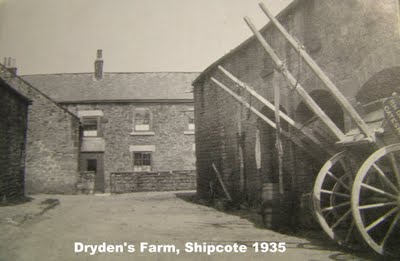
Left click to enlarge
But first Dryden Road and here's Drydens Farm in 1935 where the Fire Station now stands
Lord Ravensworth held property here before the enclosure of the common in 1806-16. In 1803 he sold the property now called Rosehill and on it was built a house of the usual Georgian type, four large square rooms on the ground floor and four similar rooms above. The demand for houses was great then as now, and two more houses were built onto the first, each with two rooms on the ground floor and two above, and in addition attics. These houses stood in the fields and had large gardens. They are now reached by a private road with a gate ( at the top of Kellfield Road )
Kells Lane, on the west of Rosehill branches off from the old Durham Road at the Three Tuns Inn and comes down hill south west. On the east side there are several detached houses standing in their own gardens. One of these named Underhill was for many years the home of Joseph Wilson Swan, who invented the carbon filament electric light bulb, which was the ancestor of our present bulbs. In 1869 he moved to Underhill and married again, and there his second family of children was born.
He left Low Fell to go to live in London in 1883, and died in 1914.
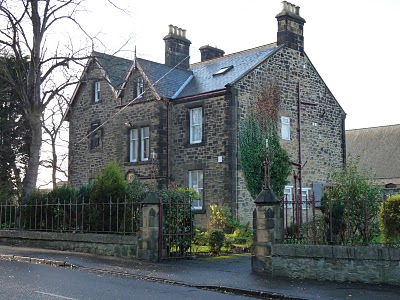
Southward along Kells Lane, next but one from The Black Horse, is the large stone house built by Mr. Kell, the first town clerk of Gateshead after the place became a municipal borough in 1835.
He must have been of independent means because one would not expect an honest local government officer to afford a spread like this...although he did have 40 years to save up, this being built in 1875. The area which was once a large garden behind the house was for many years a field, before St Peter's Church was built.
Soldiers were billetted here during WW2.
It is now the home of the priest(s)
Kells Lane was NOT named after this Mr Kell, as is often thought.. Kell's Field Estate had been in existence at least since the mid-eighteenth century... perhaps he was of this family, hence perhaps the ability to build this house
This is a section of a map of 1862 and you can see it is called Kells Lane and there are several other references to Kells Field
Rosehill was called Barras's Row
There are 3 Coal Pits shown in this tiny area.
Note the Victoria is shown as the Queen's Head.
Victoria Place (1840) and The Gateshead Arms(before 1862) are shown on the new Durham Road but little else
The Green Area is Fell House, where Thomas Wilson lived and the yellow area is the Black Horse which was a pub before 1780. The Plantation was, at that time, a plantation.Throughout this entire map 'dene' is spelt 'dean' and there are many in Low Fell. It explains to me the derivation of Dean Street, Low Fell ( and, for that matter, Dean Street, Newcastle). They are both very Dene-like
This is Home House, the former home of M. Hope Dodds who provided most of the information in this Low Fell section. It must have been built after 1862 as it is not shown on the map
Home House is currently used as a home for unmarried mothers and is at the junction of Church Road and Kells Lane
http://www.gateshead.gov.uk/ls/lowfell/intro.htm to read Ms Dodds' History of Low Fell in full
THE HISTORY OF LOW FELL STATION AREA
When the new main road was constructed the inhabitants of Low Fell walked to Gateshead or Newcastle if business took them there, unless they had horses and carts, or donkey carts, or pony traps or rose to a carriage and pair. But the railway was approaching,
though slowly. Although it was possible to go from York to Gateshead by railway in 1844, and the great cast-iron High Level Bridge was built across the Tyne and opened in 1849 the Team Valley line was not built until some years later, and Low Fell Station was not opened until 1857. It was right down in the valley reached by the road down Belle Vue Bank, which was never properly made in its lower part. Several large houses with pleasant gardens were built down by the station by business men who
found the trains convenient, but though there are made roads and terraces of houses round about the site now, it was not much used, and not much missed when the station closed
About the same time as the opening of the railway station a much more popular form of transport appeared on the main road, an omnibus from Low Fell to Newcastle. This in its turn was superseded by steam trams.
THE HISTORY OF SODHOUSE BANK AREA ( Top Kells Lane/Top Church Road)
This is a section of the 1862 map
Note the Travellers Rest was called The Golden Quoit
This is the oldest marked building found so far. It's shown on the map..it is a double glazing shop. Note the pottery references. This buiding, and opposite is Blue Quarries Road. just off the map to the north is shown Sheriff Hill Pottery at the junction of Old Durham Road and Pottery Lane. In current names we have Pottersway and The pub, The Brown Jug formerly called The Jug
The Hermitage was on Old Durham Road opposite and midway between the tops of Valley Drive and Evistones Road
Read more here
STREET SIGN Inconsistencies in LOW FELL

Lowery's Lane named after Mr Lowery and so has an apostrophe S

It still has the apostrophe but the E and the R in Mr Lowery's name are now transposed

And here the spelling is the same as the previous but where is the apostrophe?
You may be forgiven for believing that these are variations used over a period of time but no...these are all currently on display. What do the schoolkids who go to the school bounded by Kells Lane and Wilsons Lane think of this lack of consistency?

That's Kell's Lane with an apostrophe, and

Kells Lane without, both currently shown

and Wilson's Lane with an apostrophe

and Wilsons Lane, without
Wilson was a teacher..what would he think of such sloppiness?
And talking of "sloppiness", who spotted the deliberate error, earlier?


Joseph Swan Brian Blessed
One's a Sir..the other one will be!
(You read it here first)
The pane of glass is preserved in the Wesleyan church, allegedly. Subsequently, there was a small methodist meeting house that was demolished because it stood in the way of the new Durham Road, built in 1826


Left click to see it as it is now
but another, Bethany Chapel, building on the left, was built to replace it on the east side of the road. This is now Greggs the Bakers.

Left click the image to see it now
Chowdene Chapel (above), no longer Methodist, on the west side of the road was then" it " until the current Wesley Memorial was built in 1882, opened 1883
ST. JOHN'S CHURCH
The building of St. John's was financed by the Hawks family who owned large ironworks on the Tyne. The church was completed and opened in 1825, the Rev. William Hawks was the first rector, and the rectory was built for him by his father, Sir Robert Shafto Hawks.
The Rectory, Hawksbury House, is at the top of Kellfield Avenue and is now a residential care home. The church stands on almost the highest summit of the Fell, Sour Milk Hill. It is over 500 feet above sea level, one of the highest in England. The spire of St. John's church is a landmark and can seen for many miles in Northumberland and Durham, and from the sea;. The Hawks family made other benefactions to the church. Lady Hawks gave the communion plate, for example. To this day, just to the left of the east gate to the grave yard, leaning against the wall is the gravestone of Dorothy Smith in the servitude of Lady Hawks for 50 years..only that bit can be made out. Thomas Wilson, the Bard of Low Fell is buried in the grave yard as is Robert Clement of the New Cannon Inn...at the west boundary wall of the graveyard, near the main entrance of the church

The Parish of Saint Helen owes its existence to the large population explosion. Low Fell had been but a small village on the Southern edge of Gateshead - coal mining being the principal occupation. The opening of the Gateshead to Durham Turnpike in 1827 served to put Low Fell on the map and many of the industrialists of Gateshead and Newcastle built large houses in the area, this being followed by a steady growth in population generally. It was a hellava hike up to St John's and so the entire cost of the Church - £13,000 - was met by Edward Joicey of Whinney House, Low Fell who was a partner in the firm of Joicey and Co., colliery owners. The Church was consecrated on 29th August 1876. There's loads more on St Helens Website
Low Fell History must include it's famous son,
THOMAS WILSON
Thomas Wilson is the name of the best known character who was a native of Low Fell, though his fame did not spread beyond the district in which he lived.
He was born on 14th November 1774, in Low Fell. His father was a pitman. There was no restriction on child labour in the eighteenth century, and Thomas Wilson went to work in the pit when he was eight years old. He must have been a clever child who had already learned to read and write.
He worked in the pit until he was nineteen, and then began to teach in a school at Galloping Green about a mile from Low Fell. It must have been just such a little village school run by the schoolmaster for his own profit as the one in which Thomas Wilson had been taught as a small child.
After some years of teaching in this and other schools, where the pay was probably even less than he could earn in the pit, he got a job as a clerk in a Newcastle firm.
After several years of experience with different firms in Newcastle, he was taken into partnership with William Losh and Thomas Bell, forming the engineering firm of Losh, Wilson and Bell, and also the chemical firm called the Alkali Company, in the year 1805, the year of Trafalgar.
Thomas Wilson prospered. He married and had children.He bought a house with large grounds on the land between the New Durham Road and Kells Lane. Thomas Wilson's house faced onto Weathercock Lane, which connected Kells Lane with the new road, and his ground extended to Lowrey's Lane, the next street connecting the two roads. Wilson's house was called Fell House, and had a gate opening onto the main road as well as the entrance from Weathercock Lane. Fell House was situated on what we now know as Lowrey's Lane Car Park, the entrance and frontage of the grounds extending from Sunlight Cleaners to the Chinese Takeaway
Thomas Wilson wished to help children to get a better education with less difficulty than he had known and also to encourage adult education, therefore as soon as he was in a position to do so he set to work to establish a reading room and school in Low Fell.
On the opposite side of the new Durham Road to Fell House there was a level open piece of land, with the Crown Inn on its north side. The Crown Inn is now Bar Mondo The site was bought from William Laing in January 1841.
Money was raised by two issues of five shilling shares, which produced two-thirds of the amount required, and the remaining third was raised by public subscription. The chief organisers in the project were Thomas Wilson and Mr. Hetherington, the landlord of the Gateshead Arms. It may be remarked that there was a staircase leading from the reading-room to the Crown Inn, but this was subsequently closed. The architect was Thomas Oliver of Newcastle, and the builder Thomas Liddell of Low Fell. There was a grand opening dinner on 9th November 1841. The building contained a reading room, lecture room and schoolroom. Seven trustees, headed by Thomas Wilson, were appointed to manage the use of the building for its proper purposes.
The Pitman's Pay, Wilson's chief literary work, appeared originally in Mitchell's Newcastle Magazine in 1826-28 and 1830. Other poems were contributed to the Tyne Mercury and some of these were reissued with notes by John Sykes, compiler of local records. The Pitman's Pay is a metrical description, much of it in mining language, of the incidents and conversations of colliers on their fortnightly pay nights. Others of Wilson's verses, the poem entitled 'On seeing a mouse run across the road in January' for example, show him to have made a close study of Burns. Some consider that in the 'Tippling Dominie' Wilson is perhaps seen at his best.
Wilson died at age 84 at Fell House, Gateshead, on 9th May 1858 and was buried in the family vault at St John's. His funeral was attended by the Mayor and town council.
The grave is in an extremely neglected state
It is not possible to read all of the inscription but the heading reads The Family Burial Place of Thomas and Mary Wilson of Fell House in this Parish
It also says Thomas Wilson Senior...is the author of the Pitman's Pay and other poems
Who reckons, like me, that it would cost the Council very little if it got it's Parks Dept to keep the burial place in better order?
The Pitman's Pay is extremely long and can be read by clicking the link
lIn 1923 Lloyd's Bank bought the Wilson school building. No longer a bank the building is up to let
The History of Low Fell continues with...
THE BUILDING OF DURHAM ROAD THRO LOW FELL
To the people who urged that it was too hard on the horses to have to drag coaches and wagons up a long steep hill (that was Old Durham Road) and then down another( way, way down to Birtley), the canny folk of Wrekenton replied that horses liked a variety of level and thrived on up and down roads while they found a more level line exhausting:
here's Thomas Wilson
"For the very wise heads up at Wrekenton Town
Had labour'd to settle these two simple points,
That the horses' delight is an up and a down,
A hill clears their wind and relaxes their joints."
Pull the other one, Wrekendykers
The new road began 6th December 1824, and the first mail coach passed along it on 16th June 1826. This was just when the supremacy of the mail coach began to be threatened, when George Stephenson's first steam train ran from Stockton to Darlington.
The meeting between the judges of assize and the representatives of the lords of the franchises to claim their right to hold their own courts had long ceased to be held, but it was still the custom for the High Sheriff of Northumberland and the under sheriff to come in procession to meet the judges, followed by a train of the gentlemen of the county on horseback or later in their carriages. It is said that a popular sheriff might be followed by as many as 500 gentlemen's carriages. The meeting-place was now the Cannon Inn at Sheriff Hill.
After the opening of the new main road, the New Cannon Inn was built at the foot of Buck Lane, now Beaconsfield Road, and the Sheriff's procession met the judges there as they travelled north with equal pomp, until the opening of the railway gave the judges an easier method of travelling.
Thomas Wilson described it as "the road through the fields" In 1824 there was still about a mile of farm land between Gateshead and Low Fell, with farms and cottages scattered about. Dryden's farm was where the modern fire brigade station stands, and gave its name to the modern Dryden Road. Thomas Wilson's poem about the new road can be seen
Here's a verse from it
"Then reet ower the Fell, and by Carter's famed well,
Wheer the watter like wine ye see a'ways runnin',
And is better by far than the poor blashy yel (ale)
Folks get i' Newcassel or even i' Lunnen"
.
To this Wilson added a note: "A famous spring, taking its rise in an old pit, and issuing from a hillside on the Low Fell. It affords the inhabitants a healthy and sober beverage, free from the pernicious effects produced by the rotten stuff, often drunk under the name of ale. Of course I except home-brewed and fine old eight-penny."
Carter's Well was the chief drinking-water supply for Low Fell until near the end of the 19th century.People would take buckets to the well and bring them back full of the water to be used for drinking and cooking. Rain water would be collected for washing and cleaning the floors.
The mail coach first went along the road on 17th June 1826, and Wilson continued his stanzas.
"How 'way, Dicky, how 'way, hinny,
There's the tootin o' the horn!
If it cost a gowden guinney
Thou's be soaked wi' barley corn."
Accordingly they went first to the Buck (The Beaconsfield ) then to the Keys, (The Belle Vue) which gave its name to Cross Keys Lane, then to The Black Horse. Everybody was having a holiday, the horses and the donkeys, rejoicing that they would no longer have to toil up steep hills, the carriers, the smiths, the tailors, the cobblers, the school children and their masters. Dicky burst into a song of triumph. The Fell will be a new Garden of Eden, better than Adam's. The "jay-legg'd bodies frae the toon", in other words, the citizens of Newcastle, would no longer be able to look down their noses on the Low Fellers. We would grow grapes and peaches, there would be peacocks instead of cocks and hens, and all the mice would be white!
Best of all the magistrates had granted licences for four new inns! The Ship, (where was that?) the <<<Cannon, otherwise the New Cannon,(now Ye Olde Cannon) right on the new road at the foot of Buck Lane,(Beaconsfield Road) named after the Old Cannon on Sheriff Hill, the Engine (bottom of Engine Lane where Fell Tower Medical Centre is now), and the Sovereign (the George IV (now Aletaster).
Moulders Arms, a few doors to the South of the Belle Vue in Low Fell (the premises is now occupied by Rumour hairdressers). It closed and the licence was transferred to the Bell Vue.
To see more old photos of some of these pubs go to "Remember When" on www.gateshead-pubs.com
Dicky, in the poem, was a well known local character, Dick Fenwick of Sheriff Hill House, who was the manager of a small colliery on the west side of the new road, on the steep hillside behind the old Co-op (now a pine bed showroom) and the new flats (formerly The Capitol) See 1862 map. He used to gallop down Church Road from his house at the top to his colliery at the foot at breakneck speed. Cedar Crescent is built over the site. Dicky's Dene( Officially called Dodds' Dene) lay immediately to the south of it. Sheriff Hill House is shown on the map in the Kells Lane section below
The engine house of Dicky's colliery was on the east side of the main road and gave its name to Engine Lane The Engine House became The Engine Inn and ultimately the site was used for the building of the Fell Tower Medical Centre
<One of the earlier residential terraces to be built on the east side of the new Durham Road, ( completed 1826 )
THE HISTORY OF LOW FELL cont...d
THE POSH HOUSES ALONG DURHAM ROAD
Along the west side of Durham Road, starting at Enfield Road, the foot-path was bordered by a line of high walls, with more or less stately gates at intervals opening onto carriage drives, and usually with a lodge beside the gate. The drive led to a large house, with a flower garden.
At least two of the houses stood at the top of a hillside which might almost be called a cliff. Others were built at the upper end of a dene. Several of them had denes in the garden, which were put to various uses. A large conservatory was built over one, with the furnace and boiler for the hot water pipes underneath it in the dene, which of course was strictly utilitarian and hidden from the rest of the grounds by trees and shrubs.
Enfield House, the first of the big houses on the West side. Enfield House was pulled down and the rest of the estate is covered by Gateshead Technical College, now Gateshead College.
North Dene, the building and the grounds were still very nice in the early sixties when it was used as overspill accomodation for The Grammar School for Boys
It has now been absorbed into Gateshead College and the grounds turned over to portacabins and tarmac for car parking
The Red House, to the south of North Dene, was built later than the other big houses. Below it was Ravenshill (now demolished), once the home of the artistic Sowerbys, the owners of a glass works for which Gateshead was once famous.
The houses and grounds became more and more fantastic the further they were from the town.
The house with the conservatory built over the dene was called Heathfield, and had most remarkable grounds. The carriage gate onto the main road was very elaborate with a tall stone arch on each side and a stone lion on each
This photo was taken April 2005
In the grounds there were artificial mountains, complete with winding paths, boulders and pine trees, and a full-size metal eagle on the summit. There were other lions and eagles here and there a lake with a boat and boathouse, and an island in the lake on which stood a glass pagoda. This fantastic place belonged to a family called Lange who came from Germany and made their fortune in the coal trade. The elder was a very good business man; he never married. The younger brother married - he was the one with the romantic mind who planned the Heathfield grounds. Whenever he wanted to add a mountain or a few more lions and eagles, he told the other brother, who made some more money and gave it to him to pay for the improvement.
The grounds of all these great houses extended from the main road downhill to a very minor road called officially East Park Road and colloquially the Low Lane. On the east side of the Low Lane were the walls of the great houses, each with a door in it, and one or two with a dreary little lodge, which never seemed to be inhabited. On the west side was the public park, about which there will be more hereafter. It was bounded by tall iron railings so that the grass and flower beds could be seen. There were trees on both sides of the road which was very quiet, with hardly any traffic. The Heathfield grounds extended to the Low Lane, but on the south of Heathfield there was a field extending from the main road down half the side of the Heathfield grounds. On this field in the 1920s was built the last of the big houses, not so large as the others, with a garden beautifully laid out and kept. This is called the Chesters, though I do not think any Roman remains were ever found there. Chesters Park has been built on the grounds of The Chesters which is now a residential care home.
The garden at Heathfield was laid out in the romantic gothic style of the early 19th century, but the garden at Ashfield was designed by John Hancock in the still older landscape gardening style It is true that it had been provided with a quantity of artificial rocks, but they were overgrown with moss and bedded in grass and wild flowers. On the ridge of the steep sides there were four great old Ash Trees which gave the place its name, one at the foot, on the north side, two in the south side and one at the top of the dene, the oldest of all and covered in ivy.
The grounds of all these houses adjoined one another, and there was no road to connect the Durham Road with East Park Road, the Low Lane, before Joicey Road, which was immediately to the south of Ashfield. The side gate of the house opened onto this road and a footpath led through the garden down to the house, but the main gate with its lodge and carriage drive was on the Low Lane, the only main gate on the east side of that road, but there was one house with a gate and drive on the west. side, next to the Park. Ashfield House, photo above, is now a Nursery and is to the rear of Springs Fitness Centre on Joicey Road. The Lodge on East Park Road is of later date (1903) than Ashfield House. The gate on the west side of East Park Road is that of Grove House.
On the south side of Joicey Lane comes the only estate which was mentioned by Thomas Wilson, Whinney House. When the road was opened in 1826 it must have been a large farm not at all like its later appearance. In the middle-of the 19th century
there were four brothers who were colliery owners in Northumberland and Durham, all very rich. The youngest, whose health was poor, was not quite so rich as the others, but he was rich enough to buy Whinney House, build himself a large mansion, and lay out elaborate grounds over the former fields. This was much the largest of these great houses. The grounds stretched from Joicey Road to the first houses in Low Fell village. The principal gate was on the main road with lodge and drive. The grounds extended down past the end of the Low Lane to West Park Road. The dene in the Whinney House grounds was a very large one, to suit the size of the place. There was a deep dip in West Park Road, and at that point there was a third gate into the grounds, not an imposing one in itself, but it had quite a large house for a lodge, with its name on the wall, "The CWM" a puzzle for at least one youthful passer-by, for how could you pronounce CWM? I suppose now that Mr. Joicey thought his valley was larger than a dene, it was a combe. It was very lovely in springtime, full of flowering trees, apple and cherry and red and white hawthorn. The West Park Road referred to here is now Saltwell Road South. Old maps do not show an entrance to Whinney House from West Park Road although there was a house in the dip opposite the Ninepins at the foot of the dene. This house was demolished and two houses erected on the site. An entrance into the grounds of Whinney House is shown on Joicey Road (now an entrance to allotments).
Having dealt with the houses on the west side of the main road from Shipcote to the village of Low Fell, we must cross to the east side. The two houses farthest to the north were built early in the 20th century, later than most of the houses on the west. One, Springfield House, stood behind the later Springfield Hotel. It was demolished and the hotel extended.
The other, with a large garden separating it from the main road, is Lindum House; in the centre of the roof there were two chimney stacks connected by ornamental metal-work, and so the house was known as the House with a Handle. It is now the Lindum Club.
The stumps of the chimney stacks
can still be seen
South from it there was a succession of fields which were formerly used for corn and hay, then later for pasture, and now they are covered with streets.
Another large house was much farther to the south, about opposite to Heathfield. It was called Musgrave and was built for the Allhusen family, who were of German origin like the Langes, and had chemical works on the Tyne. It is in the William Morris style, but in a much more agreeable form, with stone walls and a slate roof, no red and white brickwork - rather narrow pointed gables and tall slender chimneys ornamented with plasterwork. The lodge was a low building, with diamond-paned casement windows and a general medievalish look. The garden was surrounded by a high stone wall, above which appeared the tops of rowan trees covered with creamy-white blossom in early summer and with scarlet berries in early autumn. The house and front garden still are there, for a long time it was a private school, and then neglected for a long time and this photo was taken in April 2005 before it was converted into appartments
THE HISTORY OF LOW FELL cont...d
SALTWELL PARK
This picture, and several others elsewhere on this page, are from http://www.picturesofgateshead.co.uk/postcards_gateshead1/ which has lots, lots more and is well worth a visit
1876 saw the opening of Saltwell Park.
The Park is in 3 bits. This bit is the large northern area comprising the Northern Field (for picnics and events) the play areas for kids, the lake, tennis courts and bowling greens. Nice but utilitarian, as is the southern bit which is
The Grove, the grassed area that contains the bandstand. This is Grove House. It looks majestically down The Grove and is, within the curtilage of the Park, but separated from it by a wooden fence.
The crowning glory of the park is the middle bit, the house and grounds bought from William Wailes, who made his money designing stained glass.
At the south end of his estate he built South Dene Towers, a fantastic castellated building in red and white brick, with two towers. He let it out.
(South Dene Towers >>>was demolished and the Crematorium and grounds now occupy the site )
Meanwhile in 1871 Mr. Wailes built himself another house, larger than South Dene Towers, called Saltwell Towers, in the middle of his large grounds.
As you can see ( the coloured photo above) it was also in red and white bricks and in the same Gothic, Elizabethan and French styles, an effect that would not be out of place in Disneyworld ).
Mr. Wailes continued to live in Saltwell Towers until his death in 1881, and after that it was let from time to time to various tenants, including J A Shipley who founded the Shipley Art Gallery, and then became the park museum. This is the goat pub sign exhibited at the Park Museum. There was also a decaying whale bone just outside the entrance, I recall. Saltwell Towers became unsafe and was closed in about 1970. Restoration has now been carried out as part of lottery-funded park renovation and the building reopened in 2004 as a visitors centre, cafe, and events area.
The Goat was in the house that Mr J A Shipley occupied and now it's on the wall of his Art Gallery...in the shop/vestibule area.
Lovely, I know it is ... but is it art?
Personally I think it should go back to Saltwell Towers which, while beautifully restored, is a bit boring inside and needs a Golden Goat, in my opinion
Indeed the cafe should be licensed and called the Goat Inn... Saltwell Park is the People's Park and the people want ale.
Gateshead Council, I hope you're taking notes
This is a map of the jewel in the crown.
4) is the salt well (see pic below)
5) is a Lodge House ( now called Dene House) also shown on pic
6) is the other Lodge House
7) is the rose garden
8) is themagnificently restored dene. It is truly beautiful and
MUST be visited
9) is Saltwell Towers
10) is the Animal/Bird area
11) Wailes' original stables, now an education centre
12) is South Park
13) is the restored maze, exactly as it was when Wailes built it for
his own family
14) is the octagonal garden
< This is 6) the other Lodge House
Detail on the gable end. This was built after the Park was created in 1876
THE HISTORY OF LOW FELL Cont...d
THE PUBS OF LOW FELL
In 1809 it is said there were only 4 pubs in Low Fell...The Buck, Cross Keys, Black Horse and Duke of York (where was Duke of York?)
The most important crossing in Low Fell, is where Beaconsfield Road (once Buck Lane) comes down hill from east to west, crosses the main road, and becomes Belle Vue Bank. At the north west corner where Belle Vue Bank begins there was once an inn called the Spade and Rake, in order to appeal to gardeners; there were market gardens on the Fell, and there were the gardens and grounds of the big houses already described - the name must have been meant to appeal to them.
But as the New Cannon Inn, now Ye Olde Cannon, was just across the main road in the south east corner of the crossing, The Cross Keys Inn, and now called the Belle Vue Hotel was only a short distance along the main road to the south, The Buck Inn, now The Beaconsfield Hotel just a few yards up Beaconsfield Road and the Beehive Inn (long gone) was a short distance down Belle Vue Bank, it is not surprising that the Spade and Rake could not survive so much competition. All these pubs, except the Cannon pre-date the building of the new Durham Road in 1826.
The original new Cannon was built because of the new road, the actual current building is dated 1939.
It is a pity that the current owners have not kept to the historical significance of the name. The current signage suggests the pub's name stems from a large military cannon when in fact it was a small thing designed to make a noise. A local rhymester in 1751 wrote verses describing the welcome to the judges with "bells, trumpets, and cannons loud", and the original inn seems to have been named after that cannon, and had a small wooden cannon as a sign
(The Spade and Rake inn was turned into a private house, the yard in front of it into a walled garden, with a little fountain in it, there was a gardeners' cottage next to the house, and the outbuildings were cleared away and became a Bank but now the Northern Counties Insurance Office
The Crown Inn, pre-dates the buiding next door dated 1841, and is now Bar Mondo. The Gateshead Arms has been the Gateshead Arms since built in the 1830s, except for a brief moment in 2000? when it was called Smart bar. The Engine Inn, at the bottom of Engine Lane, is long gone.
The Aletaster was the George IV and before that The Sovereign, built in the 1830s
The Victoria Bar and Kitchen was The Victoria Inn and before that The Queen's Head and dates from 1810
< The Black Horse has been that since it's inception in the late 1700s..see in the original lease on the wall in the bar
There's also The Jolly Miller ( built in the latter part of the 1960s ), The Angel View ( previously the Barn, converted to a pub in the 1970s ) The Gold Medal ( briefly called the Porcupine Park and originally established in the 1970s to commemorate Brendon Foster's Gold medal ), The Ninepins, ( 1950s ) The Three Feathers ( late 1960s ), The Beacon ( 1950s ) and
<The Three Tuns ( built sometime before 1832, then demolished and replaced by the current building in 1923 ), The Travellers' Rest,( previously called The Golden Quoit and still nicknamed The Quoit, dating from the 1800s )
To visit all of these pubs, click on www.gateshead-pubs.com
History of Low Fell
.... KELL'S LANE
Left click to enlarge
But first Dryden Road and here's Drydens Farm in 1935 where the Fire Station now stands
Lord Ravensworth held property here before the enclosure of the common in 1806-16. In 1803 he sold the property now called Rosehill and on it was built a house of the usual Georgian type, four large square rooms on the ground floor and four similar rooms above. The demand for houses was great then as now, and two more houses were built onto the first, each with two rooms on the ground floor and two above, and in addition attics. These houses stood in the fields and had large gardens. They are now reached by a private road with a gate ( at the top of Kellfield Road )
Kells Lane, on the west of Rosehill branches off from the old Durham Road at the Three Tuns Inn and comes down hill south west. On the east side there are several detached houses standing in their own gardens. One of these named Underhill was for many years the home of Joseph Wilson Swan, who invented the carbon filament electric light bulb, which was the ancestor of our present bulbs. In 1869 he moved to Underhill and married again, and there his second family of children was born.
He left Low Fell to go to live in London in 1883, and died in 1914.
Southward along Kells Lane, next but one from The Black Horse, is the large stone house built by Mr. Kell, the first town clerk of Gateshead after the place became a municipal borough in 1835.
He must have been of independent means because one would not expect an honest local government officer to afford a spread like this...although he did have 40 years to save up, this being built in 1875. The area which was once a large garden behind the house was for many years a field, before St Peter's Church was built.
Soldiers were billetted here during WW2.
It is now the home of the priest(s)
Kells Lane was NOT named after this Mr Kell, as is often thought.. Kell's Field Estate had been in existence at least since the mid-eighteenth century... perhaps he was of this family, hence perhaps the ability to build this house
This is a section of a map of 1862 and you can see it is called Kells Lane and there are several other references to Kells Field
Rosehill was called Barras's Row
There are 3 Coal Pits shown in this tiny area.
Note the Victoria is shown as the Queen's Head.
Victoria Place (1840) and The Gateshead Arms(before 1862) are shown on the new Durham Road but little else
The Green Area is Fell House, where Thomas Wilson lived and the yellow area is the Black Horse which was a pub before 1780. The Plantation was, at that time, a plantation.Throughout this entire map 'dene' is spelt 'dean' and there are many in Low Fell. It explains to me the derivation of Dean Street, Low Fell ( and, for that matter, Dean Street, Newcastle). They are both very Dene-like
This is Home House, the former home of M. Hope Dodds who provided most of the information in this Low Fell section. It must have been built after 1862 as it is not shown on the map
Home House is currently used as a home for unmarried mothers and is at the junction of Church Road and Kells Lane
http://www.gateshead.gov.uk/ls/lowfell/intro.htm to read Ms Dodds' History of Low Fell in full
THE HISTORY OF LOW FELL STATION AREA
When the new main road was constructed the inhabitants of Low Fell walked to Gateshead or Newcastle if business took them there, unless they had horses and carts, or donkey carts, or pony traps or rose to a carriage and pair. But the railway was approaching,
though slowly. Although it was possible to go from York to Gateshead by railway in 1844, and the great cast-iron High Level Bridge was built across the Tyne and opened in 1849 the Team Valley line was not built until some years later, and Low Fell Station was not opened until 1857. It was right down in the valley reached by the road down Belle Vue Bank, which was never properly made in its lower part. Several large houses with pleasant gardens were built down by the station by business men who
found the trains convenient, but though there are made roads and terraces of houses round about the site now, it was not much used, and not much missed when the station closed
About the same time as the opening of the railway station a much more popular form of transport appeared on the main road, an omnibus from Low Fell to Newcastle. This in its turn was superseded by steam trams.
THE HISTORY OF SODHOUSE BANK AREA ( Top Kells Lane/Top Church Road)
This is a section of the 1862 map
Note the Travellers Rest was called The Golden Quoit
This is the oldest marked building found so far. It's shown on the map..it is a double glazing shop. Note the pottery references. This buiding, and opposite is Blue Quarries Road. just off the map to the north is shown Sheriff Hill Pottery at the junction of Old Durham Road and Pottery Lane. In current names we have Pottersway and The pub, The Brown Jug formerly called The Jug
The Hermitage was on Old Durham Road opposite and midway between the tops of Valley Drive and Evistones Road
Read more here
STREET SIGN Inconsistencies in LOW FELL
Lowery's Lane named after Mr Lowery and so has an apostrophe S
It still has the apostrophe but the E and the R in Mr Lowery's name are now transposed
And here the spelling is the same as the previous but where is the apostrophe?
You may be forgiven for believing that these are variations used over a period of time but no...these are all currently on display. What do the schoolkids who go to the school bounded by Kells Lane and Wilsons Lane think of this lack of consistency?
That's Kell's Lane with an apostrophe, and
Kells Lane without, both currently shown
and Wilson's Lane with an apostrophe
and Wilsons Lane, without
Wilson was a teacher..what would he think of such sloppiness?
And talking of "sloppiness", who spotted the deliberate error, earlier?


Joseph Swan Brian Blessed
One's a Sir..the other one will be!
(You read it here first)
